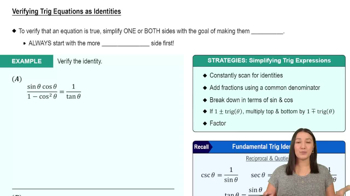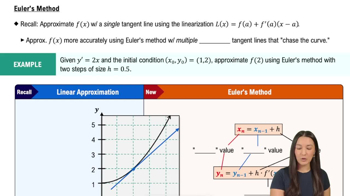Evaluate the double integral of over the region bounded by , , , and .
Table of contents
- 0. Functions7h 54m
- Introduction to Functions16m
- Piecewise Functions10m
- Properties of Functions9m
- Common Functions1h 8m
- Transformations5m
- Combining Functions27m
- Exponent rules32m
- Exponential Functions28m
- Logarithmic Functions24m
- Properties of Logarithms36m
- Exponential & Logarithmic Equations35m
- Introduction to Trigonometric Functions38m
- Graphs of Trigonometric Functions44m
- Trigonometric Identities47m
- Inverse Trigonometric Functions48m
- 1. Limits and Continuity2h 2m
- 2. Intro to Derivatives1h 33m
- 3. Techniques of Differentiation3h 18m
- 4. Applications of Derivatives2h 38m
- 5. Graphical Applications of Derivatives6h 2m
- 6. Derivatives of Inverse, Exponential, & Logarithmic Functions2h 37m
- 7. Antiderivatives & Indefinite Integrals1h 26m
- 8. Definite Integrals4h 44m
- 9. Graphical Applications of Integrals2h 27m
- 10. Physics Applications of Integrals 3h 16m
- 11. Integrals of Inverse, Exponential, & Logarithmic Functions2h 34m
- 12. Techniques of Integration7h 41m
- 13. Intro to Differential Equations2h 55m
- 14. Sequences & Series5h 36m
- 15. Power Series2h 19m
- 16. Parametric Equations & Polar Coordinates7h 58m
8. Definite Integrals
Introduction to Definite Integrals
Problem 8.1.60
Textbook Question
7–64. Integration review Evaluate the following integrals.
60. ∫ from 0 to π/4 of 3√(1 + sin 2x) dx
 Verified step by step guidance
Verified step by step guidance1
Step 1: Recognize that the integral ∫ from 0 to π/4 of 3√(1 + sin(2x)) dx involves a composite function. The term √(1 + sin(2x)) suggests that substitution might simplify the integration process.
Step 2: Use the double-angle identity for sine: sin(2x) = 2sin(x)cos(x). This identity may help simplify the integrand or assist in substitution later.
Step 3: Consider substitution to simplify the integral. Let u = 1 + sin(2x). Then, compute the derivative of u with respect to x: du/dx = 2cos(2x). Rewrite dx in terms of du and substitute into the integral.
Step 4: Adjust the limits of integration. When x = 0, calculate the corresponding value of u using u = 1 + sin(2x). Similarly, when x = π/4, calculate the corresponding value of u. Update the limits of integration accordingly.
Step 5: After substitution, the integral should now be in terms of u and simpler to evaluate. Perform the integration with respect to u, and then back-substitute to return to the original variable if necessary.
 Verified video answer for a similar problem:
Verified video answer for a similar problem:This video solution was recommended by our tutors as helpful for the problem above
Video duration:
4mPlay a video:
Was this helpful?
Key Concepts
Here are the essential concepts you must grasp in order to answer the question correctly.
Definite Integrals
A definite integral calculates the accumulation of a quantity, represented as the area under a curve, between two specified limits. In this case, the integral from 0 to π/4 indicates that we are interested in the area under the curve of the function 3√(1 + sin 2x) from x = 0 to x = π/4.
Recommended video:

Definition of the Definite Integral
Trigonometric Identities
Trigonometric identities are equations involving trigonometric functions that hold true for all values of the variables. In this integral, the expression sin 2x can be simplified using the double angle identity, which states that sin 2x = 2sin x cos x, aiding in the evaluation of the integral.
Recommended video:

Verifying Trig Equations as Identities
Substitution Method
The substitution method is a technique used in integration to simplify the integrand by changing variables. By substituting a new variable for a function of x, the integral can often be transformed into a more manageable form, making it easier to evaluate the definite integral.
Recommended video:

Euler's Method

 5:43m
5:43mWatch next
Master Definition of the Definite Integral with a bite sized video explanation from Patrick
Start learningRelated Videos
Related Practice
Multiple Choice
56
views
